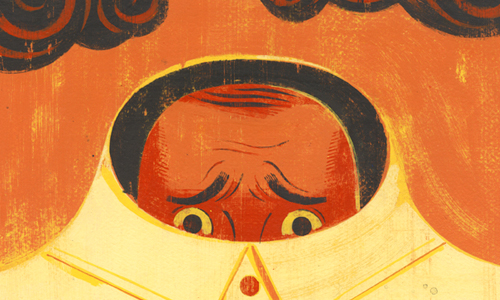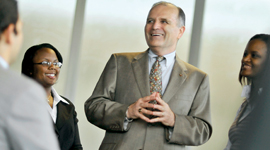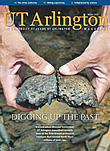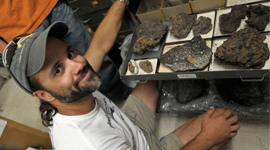The final word on stress
For more than 30 years, Professor James Campbell Quick has helped organizations effectively manage stressful situations using a two-step model that has been called a landmark in the field

Everyone faces stress. And everyone, it seems, has a theory about how to handle it. But not everyone becomes a nationally recognized authority on the subject. For that you need a prolific pen, an appetite for research and a well-timed suggestion from your younger brother.
“The thing I’ve seen the most in my 33 years of focus has been an explosion of awareness of how stress plays an important role in our sickness, disabilities and even premature death,” says organizational behavior Professor James Campbell Quick. “That’s important, because the way we react to stress is a major component of our health and vitality.”
Dr. Quick is one of the world’s leading experts on stress, having written or co-written more than 100 research papers, articles and well-received books on the subject in the last decade alone. But he didn’t get started down the path to guru-ism without a push.
He gives substantial credit to his brother, Dr. Jonathan Quick. Although Jonathan is now a physician and president of Management Sciences for Health, when he was midway through his medical program, Jim was halfway through his doctorate in organizational behavior and clinical psychology.

Organizational behavior Professor James Campbell Quick believes that a certain amount of stress helps people accomplish tasks and, within reason, equates to creative tension. But too much can be harmful. “What’s necessary is to provide both challenge and support for people,” he says, “a balancing of the stress equation.”
“My brother was studying public health notions of prevention and thought it should incorporate the organizational stress I was studying,” UT Arlington’s Quick recalls. “He predicted that we could become rich and famous with the combination.”
Jim jokes that the “rich part” didn’t happen, but the brothers have become two of the most commonly cited names in the stress arena—fame within a niche. In fact, Jim’s extensive writings over the past three decades have become essential background that shows up in textbooks and as references in scholarly
articles.
Case Western Reserve University organizational behavior Professor Richard Boyatzis, himself a noted stress expert, says the problem with most books about executive health and stress is that they make the reader “feel guilty and worry.” Not so with Quick’s work, which, he says, “creates hope.” That work includes books like Managing Executive Health, a lauded compilation of personal and corporate strategies for sustained success published in 2008. Or Stress and Strain, an overview of the psychophysiology of stress, now in its second edition, that has become a multi-language quick-study reference (“the Reader’s Digest of the world of stress,” Quick calls it).
Of Managing Executive Health, Paul Rosch, president of the American Institute for Health, makes his enthusiasm clear in a review: “This comprehensive analysis of the pitfalls and stresses associated with leadership explains why current conditions are contributing to an increase in these problems and their adverse fiscal and health effects. It contains numerous useful suggestions on how to prevent or minimize such complications so that executives can learn how to become more productive and less self-destructive.”
In addition to working with his brother, Quick frequently collaborates with other authorities, principally Joanne Gavin, associate professor of management at Marist College, and Cary Cooper, a professor of organizational psychology at Lancaster University in England and editor of Who’s Who in the Management Sciences.
Quick needs every bit of the knowledge he has gained over the years to tackle this subject. He says stress is complicated because a certain amount is essential for task accomplishment. Within reason, stress equates to creative tension.
“The artistic question is this: What is the right amount of stress in the work environment if we want to challenge people enough to bring out the best in them?” Quick asks. “But we also know that when stress is overdone, it can be harmful. What’s necessary is to provide both challenge and support for people—a balancing of the stress equation.”
And there’s another complication: People don’t react to stress in the same way. Tolerance varies wildly.
“Sure, there’s a stereotypical response to stress that includes an increase in heart rate, respiration, accelerated blood pressure and heightened alertness, but there is an astonishing variation in terms of what different people do with stress-inspired energy. Some people fight. Some run. Some freeze. There’s a lot of that—fight, flight or freeze—although the freeze part, that hunkering down thing, is the least understood. The stress response is a way to deal with threat that can be helpful if used properly.”
The “used properly” aspect often doesn’t work out, particularly in the high-pressure arena of corporate management. But the business world is steadily evolving in this area.
“Today’s recessionary environment creates a real challenge because ultimately the leader’s responsibility is for the whole organization—its well-being and survival,” Quick says. “The realities of that necessity in a downsizing world often mean companies and corporations can’t keep everybody they’ve got. That kind of dilemma does create real tension, but there are better and worse ways to terminate people.”
Quick’s strategies for dealing with stress in such situations have real-life applications. Corporations and the military have used the Preventive Management Model, which he and his brother developed.
It’s a two-step process for stressful environments: Engage in surveillance to determine who’s in emotional deep water, then engage in preventive intervention.
“Not all the problems in a highly stressful situation—say a corporate downsizing—are psychological,” Quick notes. “There can also be financial problems or other issues, or a combination of problems. Those need
to be identified and worked through on an individual basis. Though this seems simple, it sends a huge message about how important every individual in an organization is.”
Oklahoma State University Professor Debra Nelson, a frequent collaborator with Quick (they co-authored Organizational Behavior: Science, The Real World and You), terms the Quick brothers’ stress model a landmark in the field.
“His and his brother’s theory of preventive stress management, derived from public health, makes stress not an inevitable feature of work life but something that can be preventively managed,” says Dr. Nelson, who earned her Ph.D. at UT Arlington.
She also credits Quick with making stress one of the most researched topics in organizational behavior.
“He has a knack for sharing his knowledge in a way that puts stress on the front burner,” she says. “I also think what sets him apart is his generosity. He has partnered with so many and trained so many students, and he continues to operate with a servant’s heart.”
Quick is a retired colonel in the Air Force Reserve and was actively involved in managing the closure of Kelly Air Force Base several years ago—essentially an $8 billion business losing 13,000 employees, many
of them civilians. Utilizing the Preventive Management Model, he helped create an Organizational Health Center to minimize the potential mental health hazards of the shutdown.
“With 13,000 people, you have to anticipate that at least 300 to 400 will feel so stressed by the situation that severe behavior problems, including violence, could result,” Quick says. “The high-risk population has to be identified and helped.”
The outcome? Kelly recorded no stressrelated fatalities—no homicides, suicides or workplace violence. But a sister facility in California suffered 20 suicides and several incidents of workplace violence.
The reduced human suffering at Kelly—centering on identifying people with emotional difficulties and working with them—is difficult to value in human terms. But there’s also a dollar impact. The intervention saved the Air Force an estimated $33 million in complaints and lawsuits that didn’t happen.
While Quick’s history in stress management is deep and extensive, he’s far from wrapping up his career. Just this year he received UT Arlington’s award for Distinguished Record of Research, and he was named to the University’s Academy of Distinguished Teachers in 2008. He also is the John and Judy Goolsby Distinguished Professor in the College of Business.
He was a founding director and former executive director of the prestigious Goolsby Leadership Academy, which provides a select group of undergraduates with training in leadership and management skills. And he’s a visiting professor at Lancaster University in England.
In late 2008 Defense Secretary Robert Gates appointed Quick to a Department of Defense psychological health subcommittee on how to treat the problems of soldiers returning from combat experience, the
most common being post-traumatic stress disorder and traumatic brain injury.
Quick plans more books, more articles and more research. And, of course, more collaborations. These days he’s interested in high-level corporate stress, particularly among CEOs. He’s a frequent speaker on the topic, the operant title of the talk being “The Dark Side of Management.”
“Executives at higher levels often feel isolation and loneliness,” he says. “They have very limited ways to deal with their need for companionship and affiliation. It can lead to neurotic behavior. The good news is that only a small number of such CEOs are affected in this way.”
Those CEOs can expect to hear from Quick soon enough, as he continues to research and write on the subject that has become his passion.















